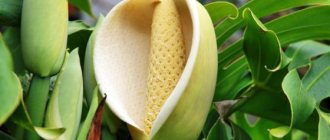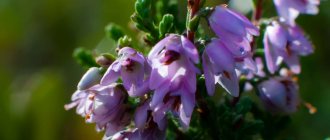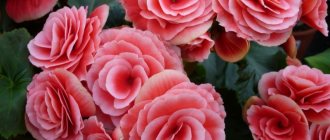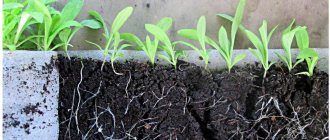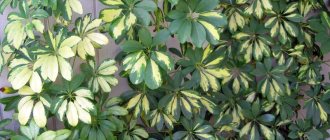Author: Elena N. https://floristics.info/ru/index.php?option=com_contact&view=contact&id=19 Category: Houseplants Published: February 24, 2019Last edits: January 11, 2021
- Growing from seeds
- Monstera turns yellow
- Monstera deliciosa, or attractive (Monstera deliciosa)
Monstera is an old favorite of ours. This luxurious plant can enhance any interior. Even its notoriety does not hinder the growth of its popularity: superstitious people consider the monstera to be an energy vampire that attracts misfortune to the house.
The reason for these speculations is the aerial roots of the plant, which in nature sometimes form entire thickets. And also fruits that leave your mouth feeling like the pricks of many needles. But at home, Monstera does not bloom, so it does not form fruits.
- What conditions does Monstera need for growth and development?
- How to grow monstera at home?
- How to transplant and reproduce it?
You will find answers to these and other questions in our article.
Planting and caring for monstera
- Flowering: the plant is grown as an ornamental foliage plant.
- Lighting: bright diffused light or partial shade.
- Temperature: in summer – normal for residential premises, in winter – 12-14 ˚C.
- Watering: regular and plentiful: the substrate should be slightly moist all the time.
- Humidity: high. It is recommended to regularly spray and wash the leaves with a damp sponge.
- Feeding: from March to August twice a month with complex mineral fertilizer for decorative deciduous plants; during the rest of the year, Monstera does not need fertilizing.
- Rest period: not clearly expressed.
- Transplantation: young plants are replanted annually, four-year-old plants - once every 2-3 years, old ones - once every five years, but the top layer of substrate up to 5 cm thick must be changed in pots of large plants annually.
- Garter: the vine is tied to a support dug into the potting soil - a ladder, a tube filled with moss or an artificial trunk wrapped in copra.
- Reproduction: sometimes by seeds, but more often vegetatively (cuttings and shoots).
- Pests: ivy scale insects, thrips, mealybugs and spider mites.
- Diseases: sooty fungus, stem rot.
Read more about growing monstera below.
plant (lat. Monstera) is a large vine and belongs to the Araceae family. In nature, monstera flowers grow in the tropical forests of the equatorial regions of Central and South America from the Yucatan Peninsula and Mexico in the north to Brazil in the south. At the end of the 18th century, the monstera flower was introduced to Asia, and then spread throughout Europe and Australia. I would like to believe that the name Monstera comes not from the Latin word Monstrum, meaning monster, but from monstrosus, which means “amazing, bizarre,” but the myths that haunt the plant cast doubt on this.
- Gerbera: home care
European explorers of the South American tropics were not so much surprised by the tree as they were frightened: the monstera vine is of such impressive size that it looks intimidating. And where fear arises, legends are born, for example, that the monstera is an energy vampire, that the roots of the monstera entangle the victim and strangle him, and all that. Let’s not retell fables, but rather let’s talk about what the monstera indoor flower actually is in modern floriculture.
Monstera - what kind of plant is this?
Monstera has become the most fashionable indoor plant. Spectacular green leaves decorate both classic and modern interiors. Monstera is native to South and Central America. It occurs naturally, among other places, in southern Mexico. In total there are 37 species of the popular plant.
In nature, monsteras are creeping plants, so the shoots of a domestic specimen should be attached to a support. Thanks to this, she will climb up. Monsteras grow relatively slowly, but can reach really large sizes. If you are planning to purchase this indoor plant, prepare enough space for it.
Hole monstera has large dark green leaves. They are shaped like a heart. The leaves of a young plant are intact, but as they grow, characteristic notches appear on them.
- Monstera is native to South and Central America. There are a total of 37 types of plants, which have recently become one of the most popular decorations in both classic and modern interiors.
In total there are 37 species of the popular plant.
Botanical description
So, the indoor monstera is an evergreen plant, a long-time favorite of gardeners who appreciate its exotic beauty and ease of care. Monstera at home grows to four meters in length, literally within 5-6 years, but since the plant is a vine, it needs stable support. In addition, using a support is very convenient, since a large monstera takes on the shape of a tree and takes up less space, and also looks more impressive. Carved monstera leaves reach a diameter of 45 cm, and young leaves are whole, but over time holes appear in them, and the larger the leaves become, the more slits there are in them.
In addition to the ordinary roots with which in nature the vine grows as an epiphyte to a tree, the aerial roots of the monstera are also of great importance, reaching right down to the ground and feeding the plant from the soil. Monstera blooms in the same way as other araceae, with an inflorescence similar to an ear of corn wrapped in a blanket. The monstera fruit is a berry about 20 cm long with a banana-pineapple flavor. By the way, in Australia, monstera is bred precisely for its nutritious and tasty fruits. But a monstera grown indoors is unlikely to be able to treat you to a delicious fruit, since monstera blooms infrequently at home.
Features of care
The basis for proper care of a monstera at home is the proximity of the created conditions to its native ones, that is, to the tropical ones.
What is typical for the tropics? High humidity and warm air. But that’s not all she needs for a comfortable existence.
Lighting conditions
Many novice amateur gardeners make one fatal mistake and place young greenery in direct sunlight, believing that in this way they provide the most comfortable conditions for it.
So they will definitely never see the main advantage of the plant - its huge chopped leaves.
In such unfavorable conditions, the leaves not only stop developing normally and forming “fingers”, the plant stops growing altogether!
However, placing the pot in pitch darkness is also not recommended. From lack of light, the leaves turn yellow and wither. The ideal solution is partial shade.
Temperature
As mentioned earlier, Monstera is a fairly heat-loving plant and needs a certain level of heat.
For summer time, temperature fluctuations in the region of 18-25 degrees are permissible, and in winter 13 degrees will be sufficient.
If you place it in greenhouse conditions, there is a chance to see the monstera bloom and even taste its surprisingly sweet fruits! However, it will grow more actively.
By the way, a little secret: if you want to slow down the growth of the plant, place the pot in a cooler place.
This monster loves warmth
She loves water
What the tropics definitely don’t have is a lack of moisture. Monstera is accustomed to this and gets very bored without regular, abundant watering. Do not upset her and do not spare water.
In the end, the plant is not so simple: it is able to independently remove excess water with the help of its leaves.
The soil should always be moist. And, of course, do not forget the main rule: in summer you need more water than in winter.
Moreover, in the hot season, you can not limit yourself solely to watering, but take the trouble to wipe the leaves of the beauty with a damp cloth.
Aerial roots - special attention
Monstera's aerial roots also require special attention. It is completely wrong to simply delete them.
She needs them to receive additional nutrition and hydration. Therefore, it is better to direct them down to the soil, providing additional support.
And the roots must be moisturized. Therefore, they can also be directed into a vessel with water.
Features of care are discussed in detail in the video:
Monstera - can you keep it at home?
Readers sometimes ask why Monstera cannot be kept at home. And really - why? I don’t know who and when examined the monstera for the presence of vampire properties or toxins, but personally I didn’t notice anything like that in it. The only factor that makes you think about whether to keep a monstera in the house is its size. A beautifully formed monstera tree grew in my house for several years, until I had to part with it because it, and not me, became uncomfortable - the monstera no longer had enough space in my modest apartment.
I gave the plant, which had become too large, to my friend, and she placed it in the lobby of her restaurant, which the monstera still decorates to this day. But if you are sure that keeping a monstera in the house is harmful, well... there are many other plants that are no worse. Well, for those who, like me, believe that Monstera can be kept at home, I recommend, just in case, not to place it in the bedroom or nursery.
Monstera is a miracle
He came to our homes from the humid tropics. There, in the natural conditions of a warm climate with very high humidity, the plant is able to bloom and bear fruit.
Although philodendron is adapted to indoor conditions, flowering, unfortunately, is very rare, since the microclimate is not at all similar to the tropics. Recreating climatic conditions close to natural for vines in a residential area is not an easy task, perhaps even impossible.
The leaves of this beautiful plant grow up to 30 cm in diameter, and sometimes more. And the height sometimes exceeds the ceiling. People call it the “crying” and “happy flower” because sometimes large drops of moisture appear on the leaves. This always happens before the rain, so he predicts the weather.
Why you can’t keep Monstera at home: signs
Various superstitions and signs are associated with the monstera. Some say that it brings good luck, others that it is an energy vampire, and others call it a monster flower. There is also an opinion that this plant is not in harmony with masculine energy, and therefore repels men from home. One can argue for a long time about its mystical properties, but there is no doubt that it is endowed with extraordinary beauty. And yet, is it possible to keep a monster flower in the house? Let's find out.
Myths and reality
Yes, there are many scandals associated with Monstera. They say that many centuries ago, in one country, human skeletons were discovered under the roots of this plant. At that time it was considered murder! But this is all fiction and speculation, and in reality the vine does not pose a threat to life.
But is this monstera poisonous or not?
Of course, there are poisonous plants, for example, Dieffenbachia, but Monstera is harmless.
Therefore, it is safe to keep the monstera at home with children and pets. However, the leaves of this plant should not be picked, as they contain microscopic splinters that can break out and cause irritation of the mucous membranes. Those who experienced it complained of a slight burning sensation.
Monstera benefits and harm
Those who do not believe in fairy tales and legends, but decide to purchase a beautiful and safe beauty, will additionally receive a number of useful properties:
- helps clear the air of harmful pollutants;
- Has a negative effect on viruses and fungi, suppressing their activity;
- Saturates the air in your home with oxygen and air ions;
- Helps ionize and humidify the air;
- Philodendron, with its large, spreading leaves, not only beautifies the environment, but also has the ability to retain dust.
Monstera flower influence on humans, signs and superstitions
- In Eastern medicine, this plant is used to strengthen the nervous system, stop headaches, develop intelligence, eliminate negative vibrations and improve the flow of thoughts.
- Monstera is capable of absorbing electromagnetic radiation, which means that it must be placed near household appliances. Monstera is not recommended in a bedroom or nursery, as it is a large plant and absorbs oxygen at night.
- In Asian countries, Monstera is considered a talisman that gives its owner good luck and longevity. It is placed at the bedside of the sick, near the entrance to the house, in the belief that it wards off illnesses and difficulties and attracts wealth.
As you can see, monstera in the house has the exact opposite effect. Everyone decides for themselves whether to breed it at home and please the eye with its unusual appearance, or to be wary of its fame.
The only reason not to get a Monstera is if you have pets or children in your family. If your pets are overly curious and your kids haven't yet gotten over the habit of trying everything, be aware of microscopic debris in the leaves. In this case, the priority should be the safety of your family, not the decorativeness of the plants. But in general, science believes that this plant is safe for humans.
Caring for Monstera at home
Growing conditions
Monstera is unpretentious, and caring for it is not burdensome. If you want the leaves of the plant to be decorated with fancy holes and slits, provide it with bright, diffused light. As a last resort, keep it in partial shade, but full shade will not benefit the decorative qualities of the plant. In summer, the monstera will be satisfied with the usual temperature for this time of year, but in winter it is advisable to give it a break from intensive growth and provide coolness - 12-14 ºC. Protect the plant from drafts and sudden temperature changes.
- Pruning plants (Part 1): is it necessary to prune? Why trim?
The soil of Monstera should always be slightly moist, and watering should be carried out based on this principle. If the monstera is in a room with central heating in winter and a temperature that is comfortable for you and not for her, then you will have to water the plant as often as in the summer. But if you place it in a cool room, then watering can be reduced. Water for humidification is used that is settled or filtered, without any admixture of lime.
High air humidity is very important for Monstera, so be prepared to frequently spray and wash the leaves of the plant in the warm season, but if you suddenly notice spots of moisture under the Monstera pot, this is a sign for you that you have overdone it with moisturizing the leaves. This ability to remove excess moisture through the leaves is called guttation. The monstera usually “gots” before rain or when the air in the room is too humid, which is why the monstera is popularly called a crybaby. In winter, replace leaf spraying with hygienic dusting and polishing of leaf plates.
Fertilizer
In the warm season, from March to August, Monstera is fed twice a month with Agricola, Nitrophoska, Seramis, Effecton or other complex fertilizer for decorative foliage plants. As soon as it gets cool, fertilizing is stopped and resumed only at the beginning of the next growing season.
Transfer
Young monstera specimens are replanted annually, those that have reached four years of age - once every 2-3 years, adult monsteras are replanted once every five years, but the top layer of soil (about 2.5 cm) must be replaced with fresh substrate annually. You need to take a larger pot for the monstera, as they say, “for growth,” since the monstera grows very quickly. The soil should be loose, light, but fertile, as for violets, for example.
The composition can be approximately this: two parts of turf soil and one part each of peat, perlite (or coarse sand), humus (or leaf soil). Experts suggest adding sphagnum, bark and charcoal to the substrate. Of the ready-made soils for Monstera, “Terra” or a mixture for palm trees is suitable. How to transplant a monstera? A thick layer of drainage is placed in the pot, then the Monstera root ball is carefully transferred and the container is supplemented with the required amount of substrate.
Monstera support
Since Monstera is a large vine, in adulthood it will need support - a wooden or plastic ladder, an artificial trunk wrapped in copra, but it is best to use tubes with holes for this purpose: the cavity of the tube is filled with moss, which is kept wet all the time, which will give additional moisture to adventitious roots. Try to direct the ends of the aerial roots into the holes of the tube - this will provide the plant, in addition to moisture, stability.
Calendar features of care
Depending on the time of year, there are certain nuances of caring for monstera:
- Summer care . The air temperature should not fall below 18 degrees Celsius. The soil should always be well moistened. Don’t be afraid to overdo it with watering: the plant itself will correct this mistake and remove excess moisture with the help of its phenomenal leaves. Try to avoid direct sunlight on the leaves of the plant.
- Autumn care . In principle, it is no different from summer care. The temperature, degree of humidification and lighting must be gradually transferred to winter mode.
- Winter care . The air temperature can be lowered by 5 degrees. Continue to water the plant so that the soil does not dry out. Direct rays of the sun, of course, should not be allowed.
- Care in spring . Spring care procedures boil down to the transition from winter to summer, that is, it includes the following measures: increasing air temperature, increasing watering.
When the monstera blooms, it turns from a monster into a beauty.
In addition, in the spring-summer period, Monstera needs bait. For this, complex feeding is perfect, which should be given to the tropical beauty once every 2 weeks.
The older the plant, the less often this procedure can be performed. However, under no circumstances should we abandon it completely.
Monstera reproduction
Monstera reproduces by seed and vegetative methods.
- Beautiful photos of croton leaves
Growing from seeds
How to propagate monstera by seed? Moist sphagnum moss is placed in ziplock bags, seeds are added, the remaining volume is filled with air and the zipper is closed. The percentage ratio is approximately this: 5% moss with seeds, 95% air. Crops are kept in a bright and warm (25-28 ºC) room. Shoots appear in two weeks or a month, and after the seedlings develop two leaves, they are planted in containers with a substrate of the following composition: one part each of sand, leaf and turf soil. Seedlings are grown at a temperature of 25 ºC in bright diffused light, transplanted into a new pot every year.
Propagation by cuttings and shoots
How does monstera reproduce besides the seed method? After all, its seeds do not have good germination, and it takes a very long time for Monstera to grow from seeds. That is why amateur flower growers prefer a faster and more reliable method of propagation - vegetative. This monstera breeding takes place from March to June. Parts of the stem with one or two leaves, the top of the trunk or lower side shoots are used as cuttings.
Monstera cuttings or its top are rooted in water under bright diffused light at a temperature of 25 ºC. The water must be changed every two weeks. After a few weeks, roots will appear, let them grow, and then transplant the cuttings into soil to sow seeds. When the monstera leaf regains its elasticity, you can feed the rooted cuttings with complete mineral fertilizer at the rate of 1 g per 1 liter of water. Some gardeners immediately plant cuttings in the ground and cover them with glass jars, thus creating a greenhouse effect. After 3-4 years, the young, strong plant is transplanted into a spacious pot.
Reproduction methods
Growing from seeds
The sown monstera seeds are placed in a warm and well-lit place. The first seedlings should appear within 30 days. The first leaf blades are juvenile and have no slits. The first adult foliage appears at 5–8 months. After 2 years, the bush will have no more than four adult leaf blades and up to 5 juvenile ones. The seedlings are first planted in individual pots, and then they are replanted every year.
Cuttings
Cuttings are carried out throughout spring until early summer. Monstera can be propagated by stem or apical cuttings, as well as by lateral shoots. A cutting is a piece of stem with 1–2 leaf blades. The cut areas are treated with charcoal powder. For rooting, the cuttings are planted in a separate pot, and the top is covered with glass. At the bottom you need to make a drainage layer from pieces of brick, cover it with a two-centimeter layer of peat or humus soil, and then pour 20–30 mm of sand. Watering is carried out regularly in the morning and evening, and the air temperature should be 20–25 degrees. After the cuttings grow roots, they are planted in an intermediate pot. After 3 or 4 years, the overgrown bush is transplanted into a tub or larger pot. In order for the cutting to take root faster, you need to choose one that has aerial roots.
Monstera. Rooting monstera cuttings.
Reproduction by apex
Old bushes lose their decorative value because their lower leaf plates fly off. In this regard, you can wrap the 2 upper aerial roots with moistened moss or twine and fix them on the trunk of the flower. After the roots grow, cut off part of the trunk with 1-2 leaf blades, and treat the cut area with charcoal powder. Plant the cutting in a pot, while covering the roots and the cut area with substrate. The old bush should also send out side shoots, and it will become more lush.
Pests and diseases
You won’t have any problems in this regard with Monstera: it is extremely rarely affected by pests, and it is also resistant to diseases. And only the most careless owners can subject the plant to attack by scale insects and spider mites, whose presence is not so easy to notice. If you do find pests, try wiping the monstera leaves with a soapy solution, but if this does not help, you will have to apply an insecticide treatment - actara or fitoverm.
But what to do if the leaves of the monstera turn yellow and then become transparent? This is a sure sign of chlorosis, so you need to buy Iron Chelate and use it according to the instructions. In lazy owners who violate the rules for caring for monstera, the plant may suffer from fusarium, late blight, anthrachnose, bacterial and stem rot, and spotting.
Monstera turns yellow
Usually, the monstera reacts to all mistakes and shortcomings in care by changing the color of the leaves - yellow spots on the leaves of the monstera are a sign that the plant is dissatisfied with your care. Why does Monstera turn yellow?
There are many reasons for this:
- if the leaves turn yellow en masse in winter, it means that you have overdone it with watering;
- if, along with yellowing, brown spots appear on the monstera, it seems that this is a case of insufficient moisture;
- if the leaves not only turn yellow, but also fall off in large numbers, this is the result of too high a temperature and insufficient air humidity in the room;
- The leaves become yellowish-pale if the plant suffers from excess light.
What to do if the monstera turns yellow? Find out the cause and eliminate deficiencies in plant care.
Monstera dries
Sometimes only the tips of Monstera leaves dry out, and sometimes necrosis spreads along the entire edge of the leaf, which negatively affects the decorative appearance of the plant.
And in this case, the question of why the monstera dries out may have several explanations:
- drafts or a stream of air from the air conditioner falling on the leaves of the monstera;
- indoor air that is too warm, too cool, or too dry;
- stagnation of water in the roots, watering in the dark or, conversely, in direct sunlight;
- The lower leaves quickly wither and dry out if the plant needs replanting.
Monstera turns black
There are also several explanations for this phenomenon. The leaves turn black when the Monstera has an unbalanced watering regime: from a lack of moisture, the leaves first turn yellow, then darken, and from an excess, blackness appears on the green leaves, and in the second case, the rot can be either dry or wet. To find out why the monstera turns black, just watch it: if during observation you find guttation, then you need to immediately reduce watering so that the leaves do not turn black later.
Monstera - how to water it?
You already know which land will be the best for monstera. Take care not only of the substrate, but also of proper watering of this popular potted plant. If you have a large, healthy monstera, water it generously once a week. This frequency will be good in spring and summer. After watering your monstera, wait about an hour and then drain the excess water from the stand.
Remember that monstera does not like too wet soil. Be careful, especially in autumn and winter, not to overwater the plant. Water approximately every two weeks when you notice that the top layer of the substrate has dried out.
For monstera, choose a light or semi-shaded position. Do not place the plant in direct sunlight.
Monstera will also curl its leaves when you place it in the wrong position. If yellow spots appear on the leaves, the plant is in too much sun. Are the spots dark? Change the place for the monstera to a warmer one.
Monstera does well at room temperature. The optimal temperature is 24 degrees; in the winter months it cannot be lower than 13 degrees. Do not place the monstera near a folding window. The plant does not like drafts.
How to water a monstera and what place to choose for it?
- In spring and summer, water the plant deeply once a week. Wait about an hour, then drain the remaining water from the base.
- In the autumn-winter period, water the plant every two weeks when you notice that the top layer of the substrate has dried out.
- Place the plant in a location that is bright but not in direct sunlight.
- If your monstera is curling its leaves, it may be a sign that the location is not suited to its needs.
- Provide the plant with the required temperature, which is about 24 degrees, and in winter it should not be lower than 13 degrees.
If your monstera is curling its leaves, it may be a sign that the stand is not meeting its needs.
Types and varieties
The Monstera genus is quite diverse in nature - about 25 species, but only two of them are grown in culture.
Monstera deliciosa, or attractive (Monstera deliciosa)
In greenhouse conditions it can grow up to 12 meters in height, in a room - only up to three meters. With good care it can bloom every year, but the fruits ripen only in a greenhouse. A variegated form (variegata) has been developed, which is more demanding of care, but does not grow as quickly as the main species. Also popular is the delicious variety Borsigiana, or Monstera Borsiga, bred from Monstera - not as powerful a plant as the original species.
Monstera oblique, or unequal-sided (Monstera obliqua)
A plant from humid Brazilian forests with graceful lacy elliptical leaves up to 20 cm long and 6 cm wide. The leaves are entire, unequal at the base, with a short petiole (12-13 cm), on a short peduncle (7-8 cm) there is a few-flowered inflorescence 4 cm long, but this species does not bloom in cultivation.
Types of monstera with photos and names
Monstera adansonii
This species is found naturally in the tropical zone from Costa Rica to Brazil. This vine can reach a height of about 8 meters. Thin ovoid leaf plates are 20–40 centimeters wide and 25–55 centimeters long. There are many holes on the entire surface of the plate. When grown at home, flowering of this species is extremely rare. During flowering, a short peduncle appears, on which a yellowish ear is formed, its length is 8–12 centimeters and its width is 1.5–2 centimeters.
Monstera deliciosa borsigiana
Under natural conditions, the species is often found in Mexico. Its stems are thinner than those of Monstera deliciosa, and the leaf blades are smaller (up to 0.3 m in diameter). The species grows well both at home and in other premises.
Monstera deliciosa
This climbing vine comes from the humid and montane forests of the tropics of Central America. It can grow at an altitude of up to 1 kilometer above sea level. Young leaf blades have a heart-shaped shape and a solid edge. As the foliage grows, it increases in size (up to 0.6 m in diameter), becomes leathery to the touch, heavily dissected and with holes. Covered with a white sheath, the cob reaches about 25 centimeters in length and up to 20 centimeters in width. The pulp of the emerging fruits can be eaten; it has a pineapple taste and aroma. The height of such a plant in a greenhouse can reach 12 meters, and at home - about 3 meters. If an adult flower is provided with proper care, flowers will appear annually. There is a variety of variegata: the foliage is variegated white, the plant itself is characterized by slower growth and higher care requirements.
Monstera obliqua
Either Monstera expilata or Monstera falcifolia. This climbing vine comes from the tropics of Brazil and Guiana, and is found in humid forests. The whole elliptical or lanceolate leaf plates are unequal at the base, their width is about 6 centimeters, and their length is up to 20 centimeters. The length of the petiole is no more than 13 centimeters. During flowering, an eight-centimeter peduncle grows, on which a few-flowered spadix about 40 mm long is formed.
Monstera pertusa
In nature, this climbing vine is found in the tropical rainforests of America. The shape of the foliage is ovoid, it looks like an elongated egg, its length is about 0.9 meters, and its width is up to 0.25 m. The holes on the plate are unevenly spaced, and the plate itself is unequal (expands more towards the bottom of the leaf). The length of the cob is 10 cm, it is covered with a white sheath, reaching a length of 20 cm.
Monstera - My favorite. Home care
Monstera transplantation and requirements for the composition of the substrate
The flower needs a large and necessarily wide pot so that the aerial roots can take root freely. It doesn't matter what material the flowerpot is made of. The main thing is for the plant to be free in it. The pot must be stable, since the vine is quite heavy, and the heavy green mass can topple the pot.
At the bottom of the flowerpot, drainage is laid at least 7 cm thick. Despite all the love for water, Monstera does not tolerate stagnant moisture near the rhizome. It is good to use expanded clay as drainage.
Due to its rapid growth and impressive size, the monstera should be regularly replanted in a larger pot. Transplantation is carried out at the very beginning of spring, as soon as the flower is three years old. If the monstera is initially planted in a large pot, it can only be replanted every three years. Each new pot is 10 cm larger in diameter than the previous one.
Monstera is planted in fertile substrate, which can be purchased at a gardening store.
Trimming / Support / Garter
How to prune monstera at home? Pruning the plant is not difficult. If the plant grows quickly and produces new shoots, then it does not need pruning.
But it happens that the vine greatly slows down its growth. Then the tops of long shoots must be trimmed to stimulate branching and the appearance of new shoots. Only the very top of the shoot is cut off, without affecting the aerial roots that the monstera puts out near each leaf.
Monstera is a climbing vine . Only at a very young age does she not need support. Usually the support is placed in the center of the pot during regular replanting of the plant. This can be a regular or bamboo stick, which is wrapped with sphagnum moss on top. This coating absorbs moisture, stimulates the growth and formation of aerial roots. You can also buy a special support at a flower shop.
The stem of the plant can be leaned against a support. But in order for the vine to stay on it well, it is better to tie it up. Secure the plant with thick twine. It is attached to the support, not tightly wrapping the shoots.
In the future, when the vine grows, the support during transplantation can be changed to a higher one.
Diseases
Monstera is affected by diseases of bacterial and fungal origin. Most often, bacteria cause stem rot and leaf spot.
When the trunk rots, the affected parts become soft and watery and acquire the smell of rotten fish. When spotting occurs, black spots appear on the leaves of the plant, surrounded by a yellow rim. Plants are treated with copper-containing preparations (Bordeaux mixture, copper sulfate solution). All affected parts must be removed.
Diseases caused by pathogenic fungi are dangerous for the plant. The most common of them:
- Anthracnose;
- Fusarium;
- Late blight.
With anthracnose, the leaves of the plant become covered with dark spots surrounded by brown and bright yellow halos. Fusarium causes rotting of the trunk with the appearance of red spherical formations on it. Late blight causes rotting of the root system and trunk.
For treatment, antifungal drugs are used, with which the plant is treated until the symptoms of the disease disappear. Affected areas of the plant must be removed to healthy tissue.
Often harmful insects breed on the vine . It is affected by spider mites, mealybugs, and scale insects. Insecticidal preparations are used to kill pests.
Transfer
Monstera transplants at home are carried out in the spring in mid-April. Young plants need to be replanted annually. Lianas 3-5 years old need to be replanted every 2 years. Large adult plants need to be replanted every 5 years.
The plant is transplanted using the transshipment method. Before transplanting, it should be watered so that the earthen lump does not crumble. A day after watering, the flower is carefully removed from the pot.
Before transplanting a monstera, you need to choose the right pot.
When choosing a new pot, you should not choose one that is too spacious. It is enough if its diameter is 2-3 cm larger than the diameter of the previous pot. A 4 cm layer of drainage is poured onto the bottom, and a little fresh soil is placed on top.
The plant is placed in the center of the new pot . The empty spaces between the earthen ball and the walls are filled with fresh soil, which is lightly compacted with a long stick or pencil. No more than 2 cm of new soil mixture can be poured on top of the old earthen ball. This flower needs to be watered well after transplantation.
In order for the vine to take root better, it is removed from the windowsill in partial shade for a week.
During the first week after transplantation, it is not watered. Then the usual watering regime for this plant is gradually resumed.


